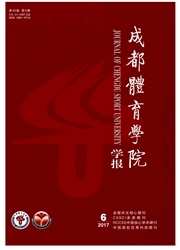

 中文摘要:
中文摘要:
目的:研究运动训练对大鼠大脑中动脉阻塞(MCAO)再灌注模型后外周血中EPCs数量的影响。方法:雄性SD大鼠参照Longa的方法改进,建立MCAO模型。将MCAO后小鼠随机分为4组①正常对照组(同步饲养);②假手术对照组;③手术对照组;④手术+运动训练组,每组均18只鼠。结果:经过缺血再灌注损伤后,手术对照组大鼠外周血EPCs数量明显升高,手术+运动组外周血中EPCs数量在几个时间点中呈现先上升后又降低的趋势,表现为2天数量与正常组并无差异,而6天数量明显上升,高于其他各组,12天数量又出现降低。结论:运动训练可增加大鼠MCAO后外周血EPCs的数量,运动对促进EPCs动员和归巢的调节作用,可以减缓由于脑缺血损伤导致的危害。
 英文摘要:
英文摘要:
Objective : To study of the impact on the number of EPC in peripheral blood after movement training on middle cerebral artery occlusion ( MCAO ) and reperfusion model . Methods: Male SD rats with reference to Longa's method improved the establishment of MCAO models. The MCAO mice were randomly divided into 4 groups ① normal control group (synchronous breeding) ; ② sham- operated control group; ③ operation control group; ④operation + exercise training group, all 18 mice in each group. Campaign Group: Treadmill Training for 2 weeks. MCAO, respec- tively, after 2d, 6d, 12d, the number of rat peripheral blood EPC changes. Results: After ischemia- reperfusion inju- ry, surgical control rats significantly increased the number of peripheral blood EPCs with 2d as the peak, 6d, 12d some- what lower than the 2d and 6d and 12d witnessed no significant statistical difference; while in the surgery + exercise group, the number of EPCs in peripheral blood of several time point showed the tendecy of first rising followed by fall- ing, the number of 2d showed no difference with the normal group, while the marked increase appeared in the number of 6d, which was higher than the other groups, but dropped in the number of 12d. Conclusion: The exercise training can increase the EPC in peripheral blood cells in rats after MCAO and the number of sports can stimulate EPC mobilization and homing; ,thereby to slow down the harm caused by cerebral ischemia.
 同期刊论文项目
同期刊论文项目
 同项目期刊论文
同项目期刊论文
 期刊信息
期刊信息
